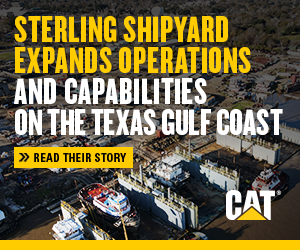NTSB Faults Bridge Tender In Atchafalaya Railroad Bridge Allision
The National Transportation Safety Board (NTSB) in early February wrapped up its investigation into the June 9, 2017, allision of the mv. Marguerite L. Terral and the Union Pacific Railroad Bridge spanning the Atchafalaya River near Krotz Springs, La. The NTSB indicated the probable cause for the allision resulted from the bridge operator’s failure to open the drawbridge.
On June 9, 2017, the mv. Marguerite L. Terral, part of Terral RiverService’s inland towboat fleet, was pushing six hopper barges as it headed downriver on the Atchafalaya River. At about 2:28 p.m., two of the Marguerite L. Terral’s barges—the starboard lead barge and the barge immediately aft—allided with a pier of the Union Pacific bridge, also known as the Krotz Springs Railroad Bridge. Though the vessel crew contacted the bridge tender at about 1:40 p.m. and indicated an estimated arrival time of 2:20 p.m., the bridge tender failed to open the span in time “due to distraction by his other duties,” according to the NTSB report. The report also cites the pilot as contributing to the accident due to “failure to properly compensate for the current during the approach to the bridge.”
The contact between the Marguerite L. Terral’s barges and the bridge caused more than $4 million in damages to both the barges and the bridge. No pollution or injuries resulted from the accident.
Synopsis Of Incident
Built in 2002, the Marguerite L. Terral measures 98.9 feet by 32 feet and features a retractible pilothouse. Fully raised, the Marguerite L. Terral’s air draft is 38 feet, while fully lowered the air draft is 16.9 feet. As the Marguerite L. Terral proceeded down the Atchafalaya that day, the Krotz Springs Railroad Bridge had a vertical clearance of 17 feet, and the river stage at the time was 23.86 feet and rising. Due to those conditions, the pilot aboard the Marguerite L. Terral and the bridge tender on duty at the time, during their 1:40 p.m. phone call, agreed the safest way to proceed past the bridge was through the opened span.
“Come on down, and we’ll have it open for you,” the bridge tender said, according to the NTSB report.
Following that phone call, the tender contacted Union Pacific to request permission to open the span and for train traffic to stop between 1:47 p.m. and 2:45 p.m. Immediately after contacting Union Pacific, the bridge tender left the station to conduct a visual inspection of the drawbridge.
“While on the bridge, he was met by two Union Pacific supervisors who had arrived unannounced to conduct an observation and performance assessment of the bridge tender (a practice Union Pacific does approximately once a month),” according to the NTSB report.
When the Marguerite L. Terral rounded the “39-mile bend” above both the Krotz Springs Highway Bridge and the railroad bridge just downriver at 2:16 p.m., the railroad bridge was still closed. The pilot slowed the Marguerite L. Terral’s forward speed. According to the NTSB report, the vessel’s pilot tried two times (without success) to contact the bridge tender by radio. While placing a phone call, the tender replied by radio to say he would need five minutes to open the span.
At 2:25 p.m.—some eight minutes later—the vessel cleared the highway bridge traveling at about 6 knots, according to the NTSB report. The Krotz Springs highway and railroad bridges are about a half mile apart. With the swinging span about three quarters of the way open, the pilot increased throttle “in an attempt to pass through the opening and ‘outrun’ the westerly set of the river current,” the NTSB report states. The maneuver allowed the pilot more control of the tow as it passed between the pivoting pedestal and the fixed pier, and yet at 2:28 p.m. “the aft starboard side” of the starboard lead barge and the barge adjacent to it struck the fixed pier.
The allision caused the two barges that struck the pier to break away. The Tony Lippman, Ryan and Charlie C, nearby towing vessels, responded and helped regain control of the two damaged barges. The other four remained attached to the Marguerite L. Terral. The impact to the bridge caused part of the fixed portion of the bridge to “shift horizontally,” with multiple pins and bolts sheered free.
Repairs to the Krotz Springs Railroad Bridge continued through August of last year.
Houston Ship Channel Fire
In another report, March 1, the NTSB released its marine accident brief on a September 6, 2016, tank vessel allision and subsequent fire on the Houston Ship Channel. The incident involved the tank vessel Aframax River, a crude oil tanker measuring more than 800 feet long and 138 feet wide.
According to the NTSB report, the Aframax River’s governor actuator system failed on the night of September 6, 2016, causing the ship to allide with two mooring dolphins in the ship channel. The allision cut a 30-foot-long gash in the ship’s hull, leading to the discharge of 88,000 gallons of low-sulfur marine gas oil.
“The fuel subsequently ignited and burned for about 45 minutes,” according to the report.
The accident closed a portion of the Houston Ship Channel for about 14 hours, caused an estimated $1.5 million of property damage and led to two pilots on board suffering minor burns.


